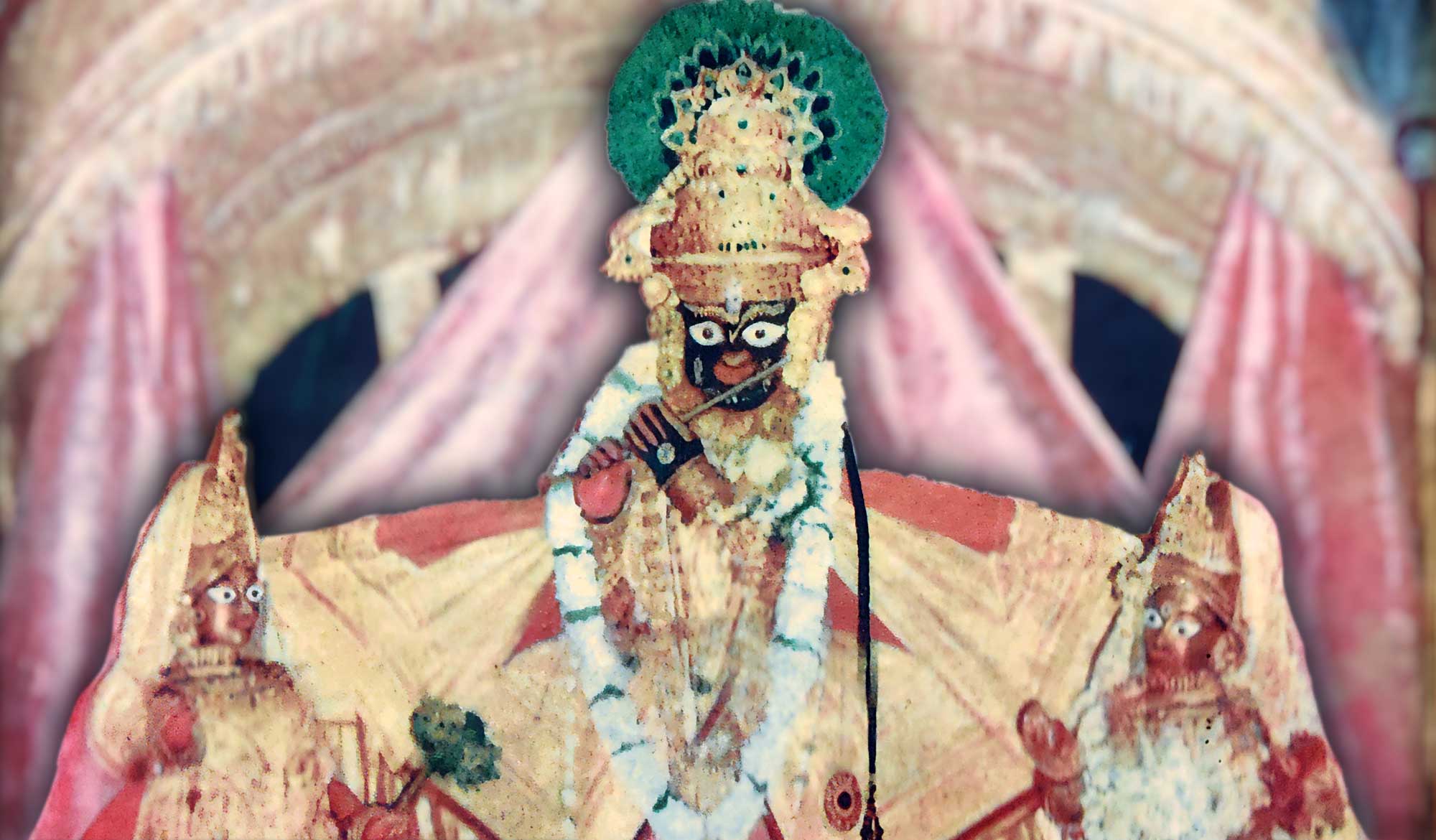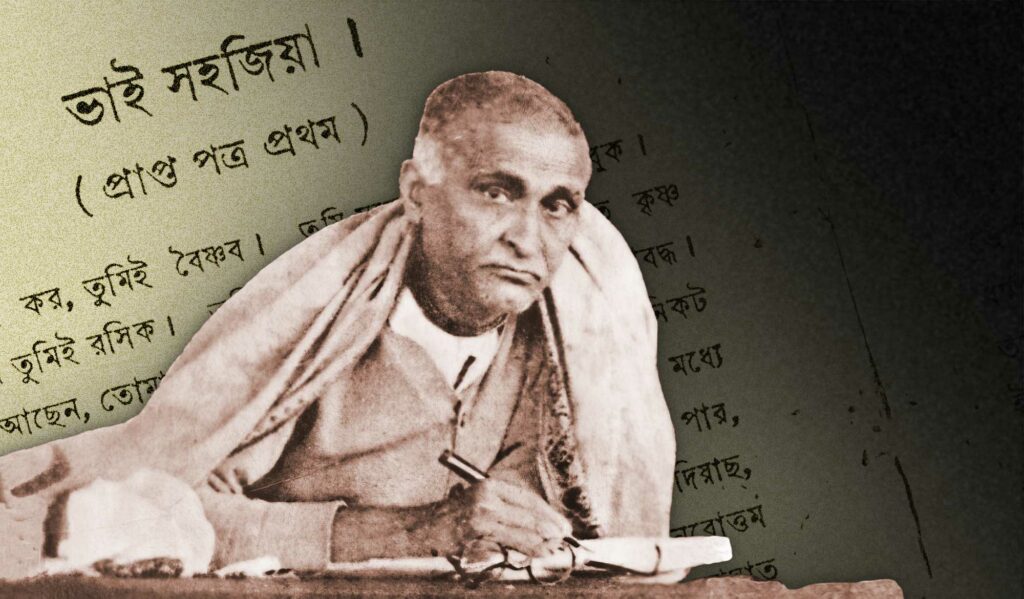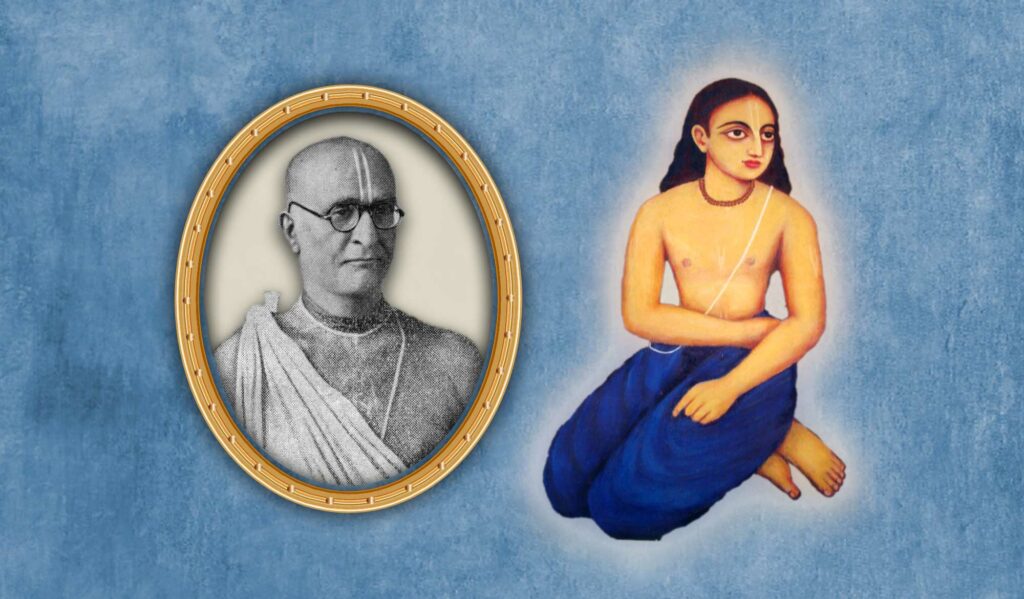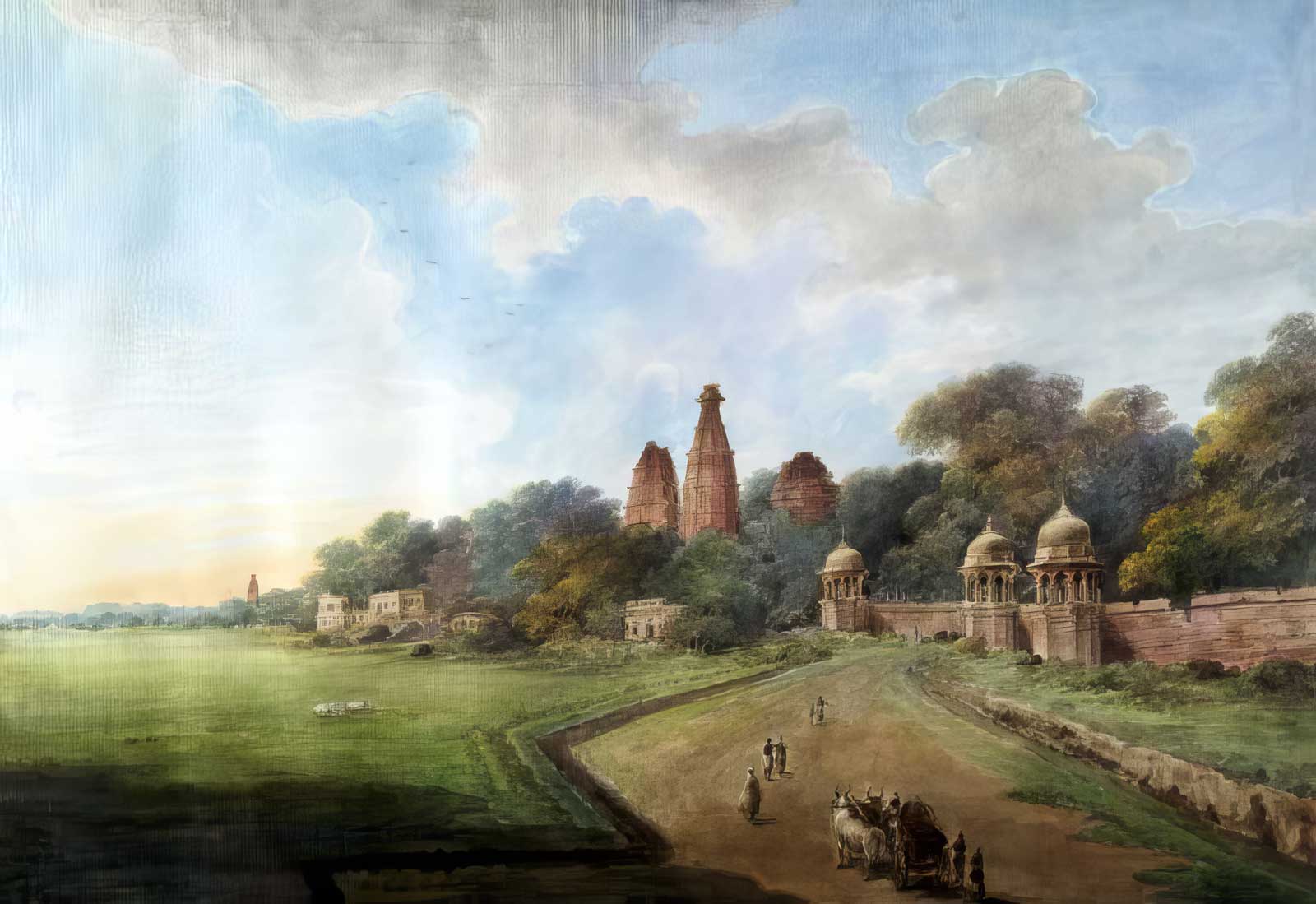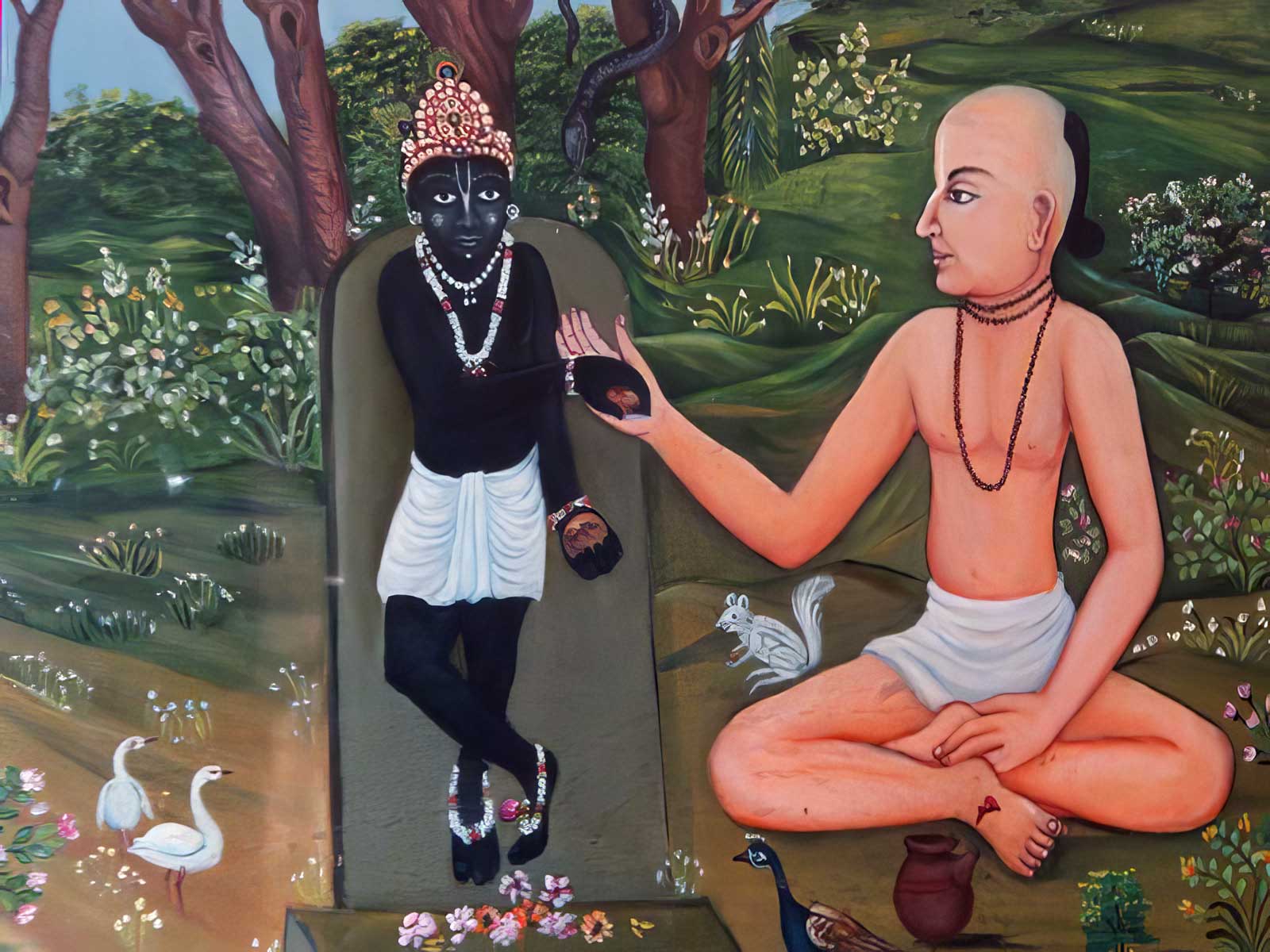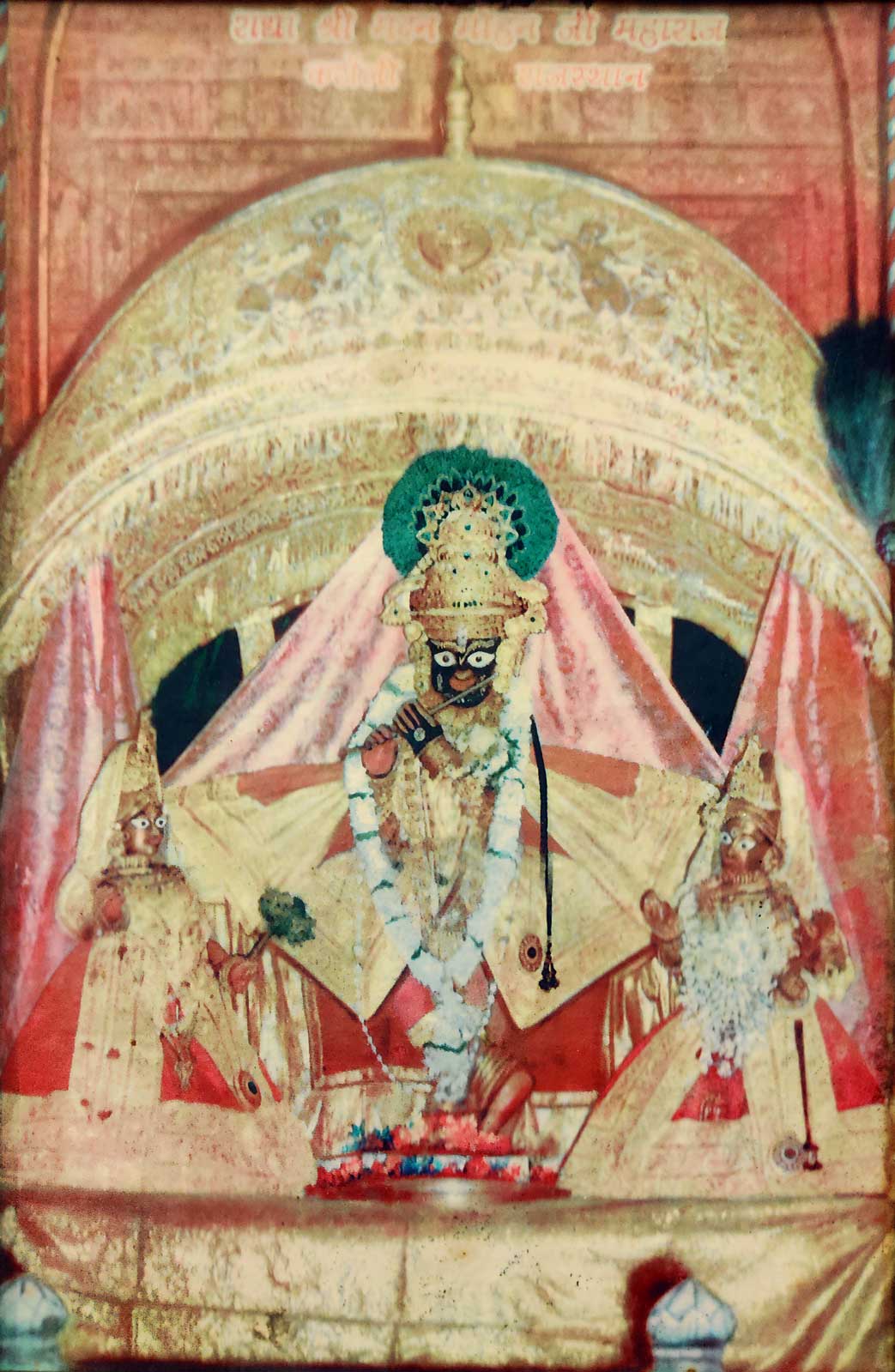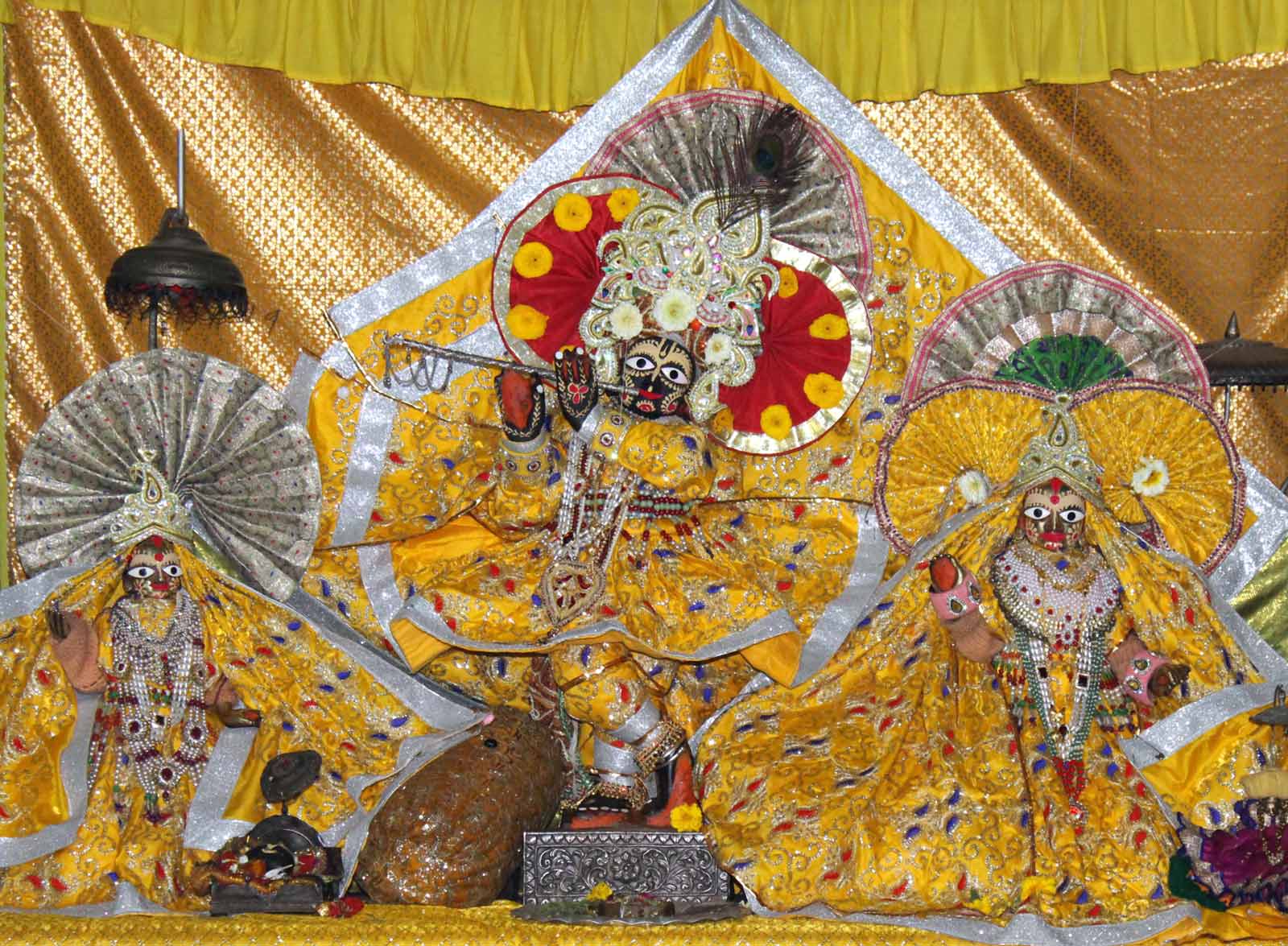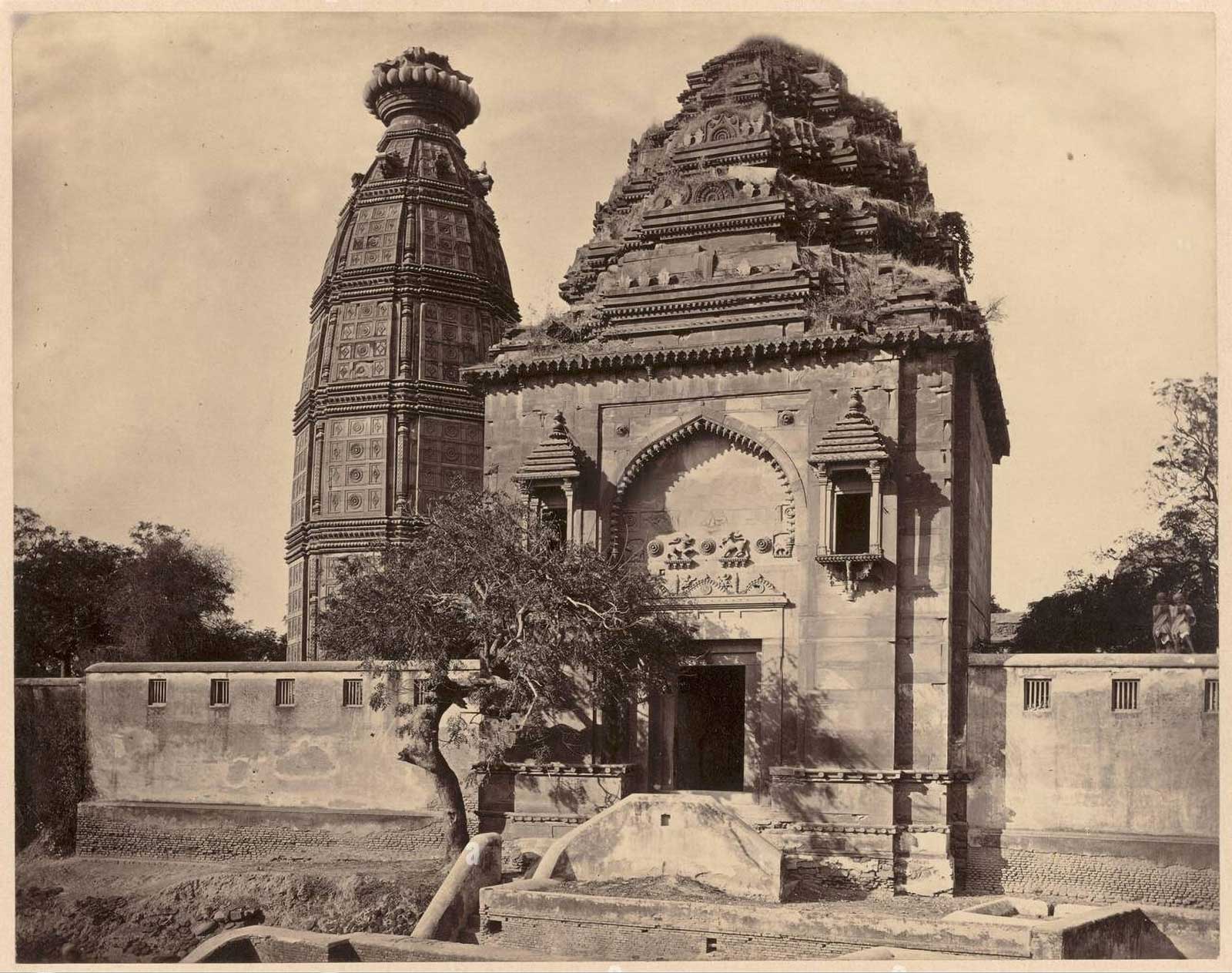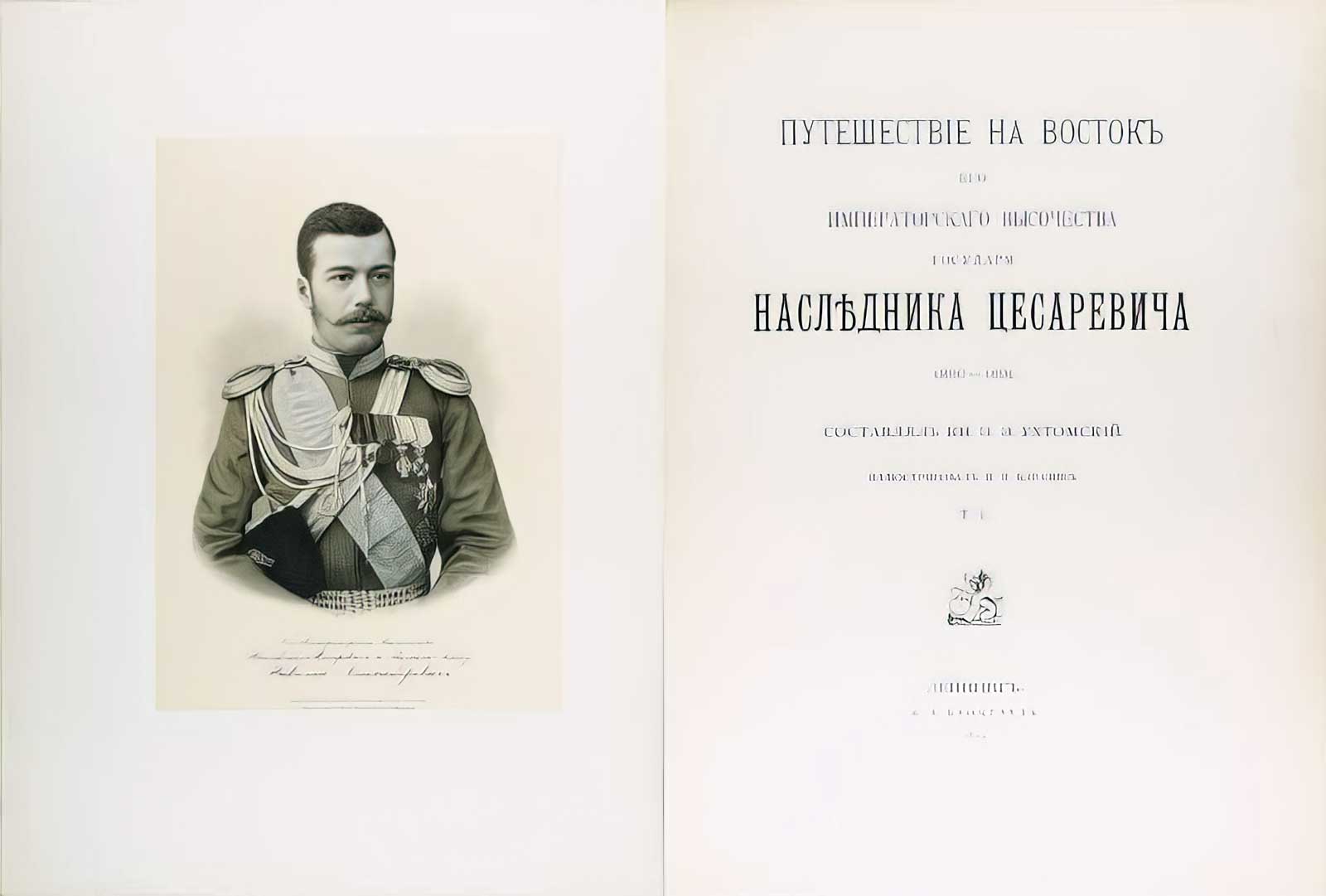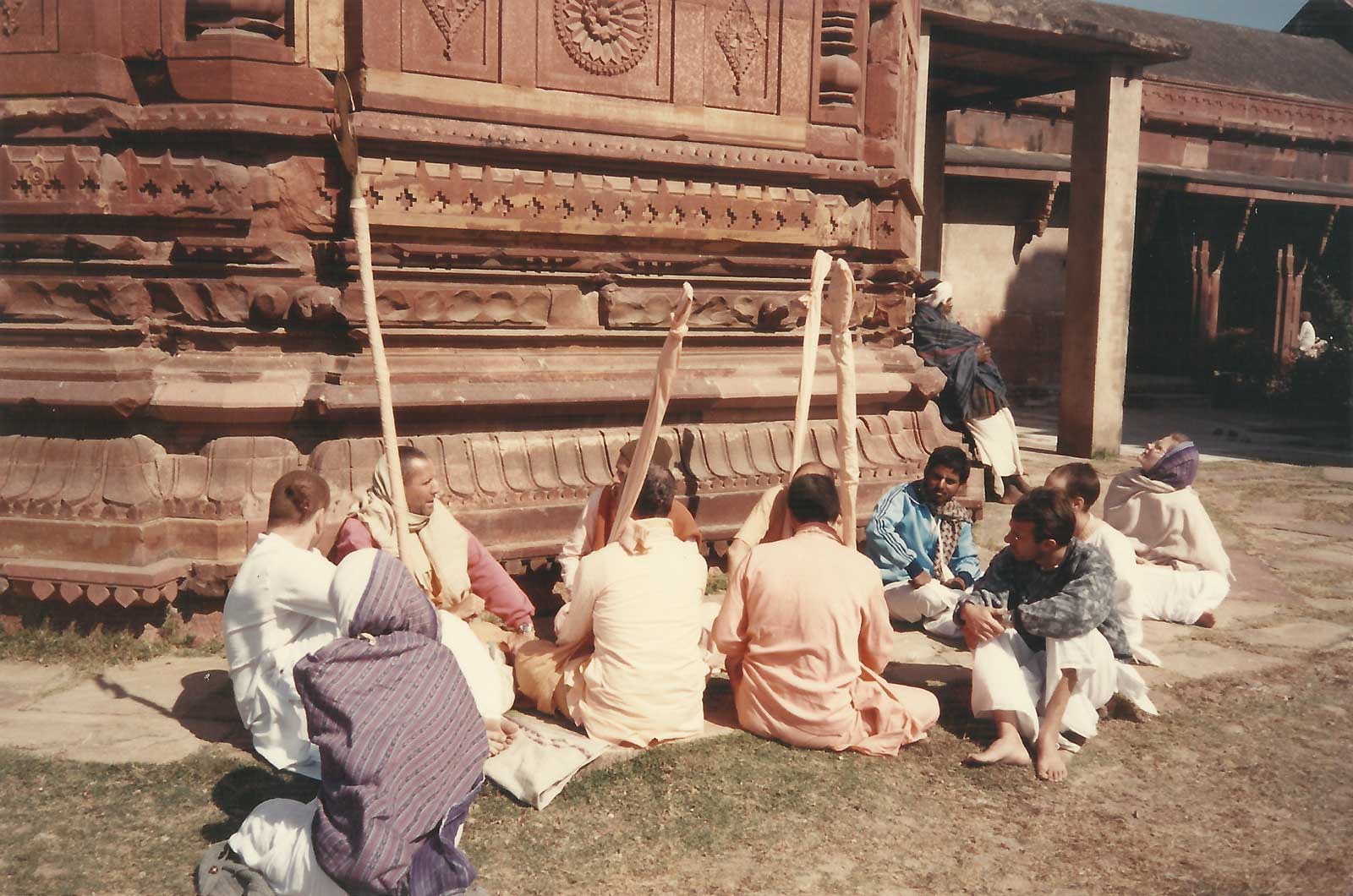Overview
Continuing with our series, ‘Pilgrimage with Swami Narasiṅgha,’ this week we go to the Madana-mohana Temple in Vṛndāvana and Śrīla Narasiṅgha Mahārāja explains the history and importance of this holy place. This article was adapted from an essay written in 1994 and a class given in Vṛndāvana in 1996.
For Gauḍīya Vaiṣṇavas there are seven major temples in Vṛndāvana – Govindajī, Gopīnātha, Madana-mohana, Rādhā-Dāmodara, Rādhā-Ramaṇa, Rādhā-Śyāmasundara and Rādhā-Gokulānanda. Śrīla Sanātana Gosvāmī built the first of the seven temples of present-day Vṛndāvana – it is probably the most famous in the sense that everyone who comes to Vṛndāvana sees it from the parikramā-mārga. That is the Madana-mohana temple.
(A European lithograph painting of Madana-mohana temple from 1814)
Madana-mohana is a name for Kṛṣṇa meaning “the attractor of the hearts of all living beings, even Cupid.” Cupid, the demigod of mundane romance, enchants everyone in the material world. But Kṛṣṇa is so attractive that He even attracts Cupid.
Originally, the Deity of Madana-mohana was installed by Vajranābha, the great-grandson of Kṛṣṇa and was worshipped in Vṛndāvana for a long time. However, when the Muslims began to invade India, then many Deities were hidden, so Madana-mohana was hidden for a long time. Eventually, Advaita Ācārya visited Vṛndāvana and one day, while resting under a banyan tree, he had a dream of Madana-mohana who told him that He was buried under that same tree. Advaita and some local vraja-vāsīs dug Him out of the ground and He was bathed and worshipped by Advaita Ācārya. At that time, Advaita named the Deity, Madana-Gopāla, and before returning to Bengal, he gave the Deity to one local vraja-vāsī brāhmaṇa to take care of. That brāhmaṇa worshipped the Deity in vātsalya–bhāva, a mood of parental affection.
(Sanātana Gosvāmī feeds Madana-mohana)
Later, when Sanātana Gosvāmī arrived in Vṛndāvana, he was begging door to door and came to the house of that brāhmaṇa. The brāhmaṇa invited Sanātana inside his home and Sanātana saw the Deity of Madana Gopāla. But Sanātana became very disturbed because the brāhmaṇa and his children were treating the Deity so informally. The children were touching Him, playing with Him, and talking to Him as if He was their elder brother. And the brāhmaṇa was chastising Him for not eating the food that was offered to Him. So Sanātana finally told the brāhmaṇa, “Look, you can’t treat a Deity of the Lord like this. There are so many rules and regulations you have to follow.” Then the brāhmaṇa apologised to Sanātana and told him that he would learn the proper standard of Deity worship.
That night, Madana-mohana came to Sanātana while he slept and told him, “Why did you disturb that brāhmaṇa? He is my devotee and he looks at Me as if I was a family member. Now you chastised him and he wants to worship Me with so much formality now, so you disturbed the mood. Anyhow, tomorrow he will come and offer Me in charity and you should accept Me.”
The next morning, the brāhmaṇa found Sanātana and told him that he wanted to give Madana-mohana to him and Sanātana accepted. From that time on, Sanātana Gosvami kept his Madana-mohana, very simply under a tree. Sanātana would go out and beg for some flour from the locals, and using water from the Yamunā, he would make some chapattis and offer them to Madana-mohana. One day he offered Madana-mohana a chapatti, and the Deity asked him for a pinch of salt to go with it. Sanātana answered, “I’m an old man. Where will I get salt? Please just accept the chapatti as it is.”
(The original Rādhā-Madana-mohana currently in Karauli (left) and their later replacement deities (right) in Vṛndāvana)
At the exact same time, a barge of the wealthy merchant, Ramadas Kapoor, ran aground on a sandbar in the Yamunā River. The Deity assumed the form of a cowherd boy and directed the distraught merchant to Sanātana Gosvāmī. Kapoor prayed to Madana-mohana that, if his barge laden with salt got free, he would pay for a temple to house the Deity. The merchant’s wish came true. And, after selling his salt for a handsome price in Agra, he returned to Sanātana Gosvāmī and kept his promise.
The red sandstone temple stands on a small hill overlooking the Yamunā River. It was partially destroyed by the Moghul Emperor Aurangzeb in the 17th Century, but much of it remains intact today. Before Aurangzeb arrived, the original Deity of Madana-mohana was taken out of Vṛndāvana and hidden in a place called Karauli in Rajasthan. It was very difficult for Aurangzeb’s army to get to Karauli, and even today the roads are pretty bad.
(Rādhā-Madana-mohana temple in the 1800s)
There is a huge part of Vṛndāvana that technically belongs to the Deity of Madana-mohana. Most of the parikrama-mārga and most of Loi Bazaar is the property of Madana-mohana. Initially, every shopkeeper in Loi Bazaar had to pay some annual rent to the Deity and that was used for the Deity sevā. It was about seven rupees, which back when they bought the property, was quite a lot of money. But today, what can you buy for seven rupees? Once, I asked one of my shopkeeper friends in Loi Bazaar, “Bābā, what is seven rupees today? Why don’t you give more to Madana-mohana? You are a lakhpati now! It’s not that you can’t afford it.” He was shocked! He looked at me as if I was telling him to cut off his arm or his leg! He replied, “No, no, no – first you have to take care of your parents, then you need to take care of the house, then the wife, then the children’s education, then clothes, then car, then food…”
I recently read that Nicholas, the last Tsar of Russia, came to Vṛndāvana before he became the tsar. He travelled by steamboat up the Yamunā and stopped at Keśi Ghāṭa. Then he got off, climbed up the hill with his party and took darśana of Madana-mohana. He was probably the first Russian to visit the Madana-mohana temple.
(‘Journey to The East’, a journal by Tsar Nicholas II about his travels in India, printed in 1890)
In the Ādi-līlā of Caitanya-caritāmṛṭa, Śrīla Prabhupāda explains that the dīkṣā-guru is a personal manifestation of Madana-mohana, and He is the first Deity to be worshiped in Vṛndāvana, because by His grace the attractive force of the material energy is slackened, allowing the devotee to be drawn to Kṛṣṇa. When one visits Vṛndāvana, the first temple you are supposed to go to is Madana-mohana, because He is the Deity of sambandha-jñāna (fundamental knowledge). Sanātana Gosvāmī is the ācārya of sambandha. Then the next temple you go to is Govindajī, the Deity of abhidheya (the process of devotional service), and the ācārya of abhidheya is Rūpa Gosvāmī. Finally one should visit Gopīnātha, the Deity of prayojana (the ultimate goal of life). Gopīnātha is the Deity of Madhu Paṇḍita, but the ācārya of prayojana is Raghunātha Dāsa Gosvāmī. Gopīnātha means ‘the Lord of the gopīs’ and the original Deity is now in Jaipur.
(Narasiṅgha Mahārāja leading a parikramā at Madana-mohana temple in 1996)
Related Articles and Books
- 📚Pilgrimage With Swami Narasiṅgha Series Index
- 📖 In Search of the Ultimate Goal of Life by Śrīla A.C. Bhaktivedānta Swami Prabhupāda
- 📖 Śrī Dāmodara Kathā by Śrīla Bhakti Gaurava Narasiṅgha Mahārāja
- 📖 Prabhupāda Vijaya by Śrīla Bhakti Gaurava Narasiṅgha Mahārāja
- The Ontological Position of Śrī Śrī Rādhā-Govinda by Śrīla B.R. Śrīdhara Deva Gosvāmī
- Śrī Govardhana Pūjā by Śrīla Bhakti Rakṣaka Śrīdhara Deva Gosvāmī
- The Vṛndāvana Express and the Navadvīpa Special by Śrīla Bhakti Rakṣaka Śrīdhara Deva Gosvāmī
- Vraja Bhāva by Śrīla Bhakti Gaurava Narasiṅgha Mahārāja
- The Worship of Govardhana by Śrīla Bhakti Gaurava Narasiṅgha Mahārāja
- Dāsa Gosvāmī and the Unique Position of Govardhana by Śrīla Bhakti Gaurava Narasiṅgha Mahārāja
- Ācāryas at Śrī Śrī Rādhā-Dāmodara Temple, Vṛndāvana by Śrīla Bhakti Gaurava Narasiṅgha Mahārāja
- Pilgrimage to Vṛndāvana-dhāma by Śrīla Bhakti Gaurava Narasiṅgha Mahārāja
- The Appearance of Rādhā-kuṇḍa by Śrīla Bhakti Gaurava Narasiṅgha Mahārāja
- Prema Dhāma Deva Stotram with the Narasiṅgha Sevaka Commentary – Verses 41-45 (regarding Imlitalā) by Swami B.V. Giri
Further Reading
Pilgrimage with Swami Narasiṅgha – Part 7: Keśī Ghāṭa
Continuing with our pilgrimage series, this week Śrīla Narasiṅgha Mahārāja takes us to Keśī Ghāṭā where he tells us about Madhumaṅgala’s meeting with the Keśī demon, what Keśī represents, and how Śrīla Prabhupāda almost acquired Keśī Ghāṭa. Mahārāja also narrates his own experience. This article has been adapted from a number of talks and articles by Narasiṅgha Mahārāja.
Prema Dhāma Deva Stotram with the Narasiṅgha Sevaka Commentary – Verses 61-65
In verses 61 to 65 of 'Prema Dhāma Deva Stotram', Śrīla Śrīdhara Mahārāja narrates the pastime of Śrī Caitanya at Caṭaka Parvata In Purī and explains how the scriptures produced by Brahmā and Śiva are ultimately searching for the personality of Mahāprabhu who is merciful too all jīvas, no matter what their social position.
Prabhupāda Śrīla Sarasvatī Ṭhākura’s Visit to Ayodhyā
With the forthcoming observance of Śrī Rāma Navamī, we present 'Prabhupāda Śrīla Sarasvatī Ṭhākura’s Visit to Ayodhyā' written by Śrīla Bhaktisiddhānta Sarasvatī Ṭhākura Prabhupāda from The Gaudīyā magazine, Vol 3. Issue 21/ In December 1924, after visiting Benares and Prāyāga, Sarasvatī Ṭhākura visited the birth-site of Śrī Rāmācandra in Ayodhyā.
Śaraṇāgati – The Only Path to Auspiciousness
In this article, 'Śaraṇāgati - The Only Path to Auspiciousness', Dhīra Lalitā Dāsī analyses the process of śaraṇāgati (surrender) beginning with śraddhā (faith). She also discusses the role of śāstra and the Vaiṣṇava in connection with surrender.
Pilgrimage with Swami Narasiṅgha – Part 7: Keśī Ghāṭa
Continuing with our pilgrimage series, this week Śrīla Narasiṅgha Mahārāja takes us to Keśī Ghāṭā where he tells us about Madhumaṅgala’s meeting with the Keśī demon, what Keśī represents, and how Śrīla Prabhupāda almost acquired Keśī Ghāṭa. Mahārāja also narrates his own experience. This article has been adapted from a number of talks and articles by Narasiṅgha Mahārāja.
Prema Dhāma Deva Stotram with the Narasiṅgha Sevaka Commentary – Verses 61-65
In verses 61 to 65 of 'Prema Dhāma Deva Stotram', Śrīla Śrīdhara Mahārāja narrates the pastime of Śrī Caitanya at Caṭaka Parvata In Purī and explains how the scriptures produced by Brahmā and Śiva are ultimately searching for the personality of Mahāprabhu who is merciful too all jīvas, no matter what their social position.
Prabhupāda Śrīla Sarasvatī Ṭhākura’s Visit to Ayodhyā
With the forthcoming observance of Śrī Rāma Navamī, we present 'Prabhupāda Śrīla Sarasvatī Ṭhākura’s Visit to Ayodhyā' written by Śrīla Bhaktisiddhānta Sarasvatī Ṭhākura Prabhupāda from The Gaudīyā magazine, Vol 3. Issue 21/ In December 1924, after visiting Benares and Prāyāga, Sarasvatī Ṭhākura visited the birth-site of Śrī Rāmācandra in Ayodhyā.
Śaraṇāgati – The Only Path to Auspiciousness
In this article, 'Śaraṇāgati - The Only Path to Auspiciousness', Dhīra Lalitā Dāsī analyses the process of śaraṇāgati (surrender) beginning with śraddhā (faith). She also discusses the role of śāstra and the Vaiṣṇava in connection with surrender.


